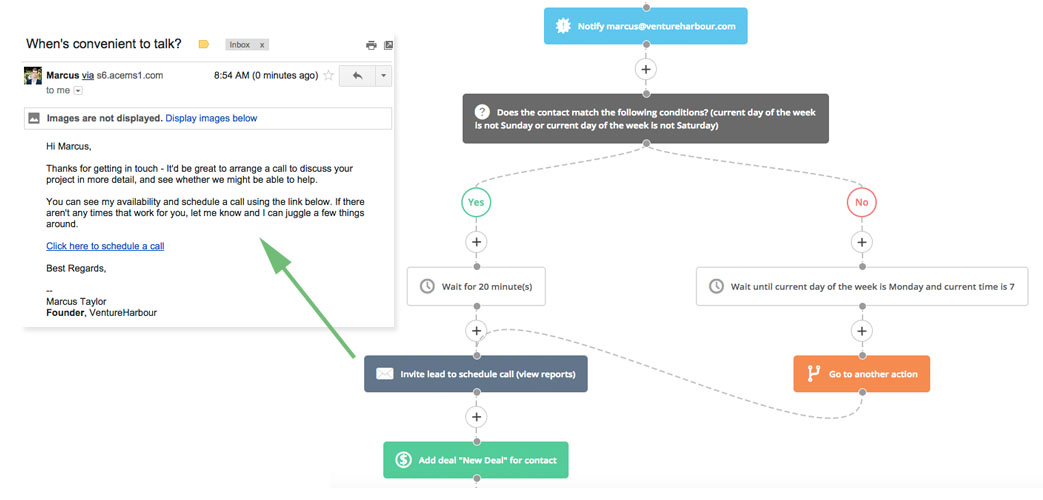How Marketing Automation improves sales
Marketing Automation Insider is supported by readers like yourself. We may earn an affiliate commission when you purchase through our links. Of course, this won't increase the cost of your subscription.

At the heart of your marketing automation software is a CRM (customer relationship management) system that stores all of your contacts and their activity.
Below are some of the best ways that you can use marketing automation to improve your sales productivity and lead conversion rates.
1. Reduce lead response times
A study by Harvard Business Review found that prospects are 7x more likely to buy from you if you respond to their enquiry within one hour, as opposed to after an hour.
Yet, the same study found that 63% of companies take longer than this to respond to enquiries.
One of the fastest ways to make your investment in marketing automation pay for itself is to implement a system for responding to leads within one hour of them contacting you.
Here’s how we did this for Venture Harbour:

To break this down:
- Leads enter this sequence after enquiring from our website (and reaching certain qualification criteria).
- Immediately, I’m notified about the lead by email.
- If it’s a weekend, a delay is set to wait until Monday at 7 am. Otherwise, a 20-minute delay is set.
- An email is then sent inviting the lead to schedule a call to discuss their project.
- The deal is added to our CRM system.
This ensures that all enquiries that contact us on a weekday are followed up with in less than twenty minutes.
2. Lead Scoring
Not all leads are created equal. If you’re not separating your whales from your plankton, you’re not being as effective as you could be.
Lead scoring provides an objective system for grading the quality and urgency of leads, leaving no room for human error when prioritising which leads to focus on.
 An example of lead scoring in Infusionsoft.
An example of lead scoring in Infusionsoft.
While each tool has a different approach, most tools enable you to create rules that automatically change a lead’s score when the lead takes a certain action, such as visiting your pricing page, or opening an email.
3. Visit Tracking & Real-Time Alerts
How valuable would it be to know precisely when your leads are thinking about your business?
Most marketing automation tools provide a snippet of code for your website that records every page your contacts visit and when. This enables you to setup alerts for when leads visit your website.
Here’s an example of a consulting lead that came through the Venture Harbour website.
We can see that this particular lead read two articles on our website, and then came back a week later to enquire about our services.
Not only is this useful for attributing where your leads come from, it also enables you to set up SMS or email alerts to your sales team the moment a potential lead visits your website.
Get used to hearing “Funny – I was just thinking about you guys”.
4. Lead nurturing
Today’s cold lead can be next quarter’s hottest lead if nurtured properly.
Lead nurturing is the process of educating your leads over a period of time to counter their objections, and build trust and desire for your offering.
Below is an example of a lead nurturing workflow in Infusionsoft. While the text is small, you might be able to see that when a lead enters this sequence, they’re first sent a series of 14 emails (over several months), after which they’re invited to schedule a call.
If the lead does not schedule a call, they’re sent a second round of educational emails with ‘arrange a call’ call-to-actions.

Lead nurturing is a mid to long-term sales strategy.
For high ticket-price items, or B2B services, lead nurturing is a powerful strategy for improving your conversion rate of leads to paying customers.
5. Use Progressive Profiling to Capture More Lead Information
Progressive profiling enables you to capture more information about a lead each time they visit your website – without having to ask for the same information over and over again.
Here’s a basic example of how progressive profiling can work:

As illustrated, you can often dynamically insert the contact’s CRM information into your landing pages and web forms, to make your offers hyper-targeted to each contacts.
For sales, this enables you to gather more information on leads while increasing the conversion rate of leads engaging with your offers.
6. Increase sales output with personalized templates
One of the most profound ways in which marketing automation assists sales is by improving the efficiency of how you contact leads.
Using personalized templates, you prevent yourself from writing the same emails over and over again. Simple, but not to be underestimated.
7. Reduce CRM Data Entry
CRM data entry is no one’s idea of fun. Not only is it mundane, it’s also prone to human error and can quickly undermine the quality of your data.
Marketing automation software vastly reduces manual CRM data entry by automatically populating CRM entries from web forms, and using automated rules to update a contact’s lead score.
Start reading chapter 3


